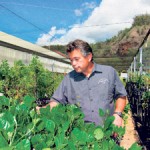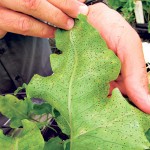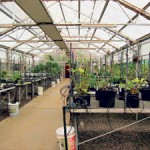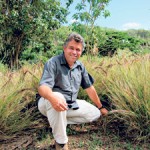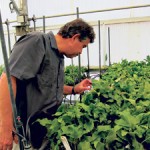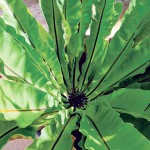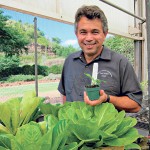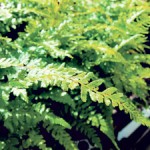Saving Hawaii’s Endangered Plants
Horticulturist Michael De Motta started as a volunteer at the National Tropical Botanical Garden and today is assistant director of the Living Collections program, in which he oversees the propagation of literally thousands of endangered plants annually and catalogs each one. He’s especially excited about seeds from Hawaii’s last known uhiuhi tree, discovered in the Waimea area
With nearly 60 percent of native Hawaiian plant species at risk of extinction, the work of horticulturist Michael De Mattos and colleagues at National Tropical Botanical Garden is crucial
Plant guru Michael De Motta is an encyclopedia of Hawaiian horticultural knowledge. The National Tropical Botanical Garden’s Living Collections and Horticulture assistant director’s eyes light up when he describes a native plant whose very existence depends largely on the efforts of his organization.
“The point is, there is always hope,” says De Motta, as he lifts a critically endangered alula seedling that he helped propagate and nurture.
“We have among the last of the wild collected stuff,” he says regarding the plant, which resembles a cabbage. “The Kaua’i population has pretty much collapsed.”
Nearly 60 percent of 1,200 or so remaining native Hawaiian plant species are currently at risk of extinction. An estimated 115 species are recorded as already lost.
By helping maintain and propagate species such as alula at different locations around NTBG gardens – including McBryde and Limahuli Garden and Preserve – De Motta can help preserve the genetic variability so the species does not become extinct. Eventually, the hope is to reintroduce them into the wild.
Nonetheless, the curve is steep as far as learning how to properly care for plants that may not still exist in the wild. Still, there is no greater reward for De Motta than knowing he has put forth every effort to save the species.
“People say, ‘Why bother, because it’s all going extinct anyway?’ But I don’t take that fatalistic point of view,” he says. “People affected the environment, and even if we don’t succeed after I’m gone, even if the forest does disappear, I still feel I have to do my little part, as small as it is, to at least slow it down.”
He’s just as determined to save the uhiuhi tree at NTBG’s nursery in Kalaheo.
The species was once believed to be extinct after the last known tree perished in Hurricane ‘Iniki’s wrath. But a NTBG staff member found an uhiuhi tree on a narrow, goat-eaten, eroded location in Waimea. Now, because of the collection of the tree’s seeds and the supervised maintenance of the propagated plant’s health by De Motta, the species has a chance for continued survival.
“You can never say, ‘It’s done,'” says De Motta, who catalogues and keeps records of every living collection plant that passes through NTBG’s five locations (McBryde and Allerton in Lawa’i, Limahuli on the North Shore, Kahanu on Maui and the Kampong in Florida).
And each of those plants is treated like prized artwork in a museum. They are identified by field collectors, tagged and treated with utmost care under the supervision of De Motta who, in turn, helps perpetuate the species. He also is responsible for keeping records of the more than 15,000 native Hawaiian plants and nearly 24,000 plants in total that are a part of the collection.
“Mike has really taken a hold of the nursery operation,” says NTBG executive director Chipper Wichman. “He has more than a green thumb, he has a green hand, maybe two of them. He has personally and professionally exhibited exceptional quality as a horticulturalist.”
Not only are thousands of plants produced every year through De Motta’s watchful eye, but he oversees a systematic processing of plants.
“He’s brought a lot of order to that part of the operation,” says Wichman.
De Motta, a Hanapepe resident who is originally from Oahu, has had a love for native plants since high school. The passion was born from De Motta’s hula practice where he learned about Hawaiian plants through ancient songs and chants.
After graduating from Saint Louis High School in 1977, he stopped dancing hula and pursued other interests, such as acting, in college. However, De Motta continued to learn about native plants and enjoyed collecting and propagating them on his own.
Prior to moving to Kaua’i, De Motta served as a tour guide for Paradise Park on Oahu, as well as for companies including Roberts Hawai’i and Globus.
He moved to Kaua’i in the mid-2000s to be able to spend more time with his family – wife Nani, who is originally from Ni’ihau and with whom he has a son, Waiola, who works at Big Save. He continued to pursue his love for conserving Hawaiian plants and not only grew his own, but volunteered his time at NTBG. His devotion eventually led him to a job at Limahuli Garden and Preserve in 2005, where he worked as a horticulturist and assisted in developing projects that re-created native forests. He also helped develop plant lists for restoration projects such as on the island of Lehua, where the growth of Hawaiian plants has been so successful that seabirds are now nesting in the native shrubs that were planted there.
“It’s just fabulous to see,” says De Motta. “All you doubters, here you go.”
The daily drive from Hanapepe to Limahuli, however, started to take a toll on De Motta after a year and a half. By then, Wichman had recognized De Motta’s commitment to his profession and willingness to go beyond the call of duty, and promoted him to his current department at NTBG headquarters in Kalaheo, where he works closely with the organization’s director of conservation, David Burney.
“His lifelong love of native Hawaiian plants and talent as a public speaker have combined to make him a leading advocate for native-plant conservation here on Kaua’i,” says Burney. “Mike is a fountain of knowledge concerning native Hawaiian plants and Polynesian cultivars. He’s doing great work at NTBG.”
Adds Wichman: “Mike has been a great mentor for our local staff as well encouraging them to build capacity and take on stronger leadership roles.”
De Motta’s future plans include a renewal effort at McBryde Garden, where he has helped plant more native grasses and sedges, and where improvements are ongoing, such as a garden specific for canoe plants (those brought to the islands by Polynesians).
He also is adamant about helping preserve native flora in places such as Koke’e, and believes that fencing off some acreage is necessary to protect the native life that remains, although that endeavor has met with some resistance from members of the community.
“People are afraid of what they don’t know,” he says. But, he explains, thousands of acres still will be left unmaintained for purposes such as hunting.
“Everything that’s up there really deserves to be up there,” he says. “The native plants are the ones that are the most threatened. Just being understanding of that and supportive of efforts to save native plants is the very least any one person can do.”
When De Motta, who speaks Hawaiian, is not promoting the conservation of plants, he spends his time hiking and practicing Hawaiian activities such as shell lei making.
“He’s one of those individuals who exude aloha,” says Wichman. “He’s just such a great person. He loves to talk story and share his culture and his passion.”
- Horticulturist Michael De Motta started as a volunteer at the National Tropical Botanical Garden and today is assistant director of the Living Collections program, in which he oversees the propagation of literally thousands of endangered plants annually and catalogs each one. He’s especially excited about seeds from Hawaii’s last known uhiuhi tree, discovered in the Waimea area
- De Motta tending to Nanea at NTBG nursery
- De Motta teaches environmental journalists about Hawai‘i’s rare, native plants
- The bright, red and green leaves of the ohia lehua plant, the first native tree to take root after a lava flow, taken at NTBG nursery
- The spores of a native laua‘e fern, taken at NTBG nursery
- The NTBG greenhouse where rare, native plants are propagated
- De Motta at McBryde Garden, where efforts to grow more native Hawaiian grass such as the one pictured are under way. Coco Zickos photos
- 7 De Motta tends to the native laua’e fern being raised at NTBG’s nursery
- Ekaha fern, taken at NTBG nursery
- Flowers from the nuku ‘i’iwi plant that resemble a honeycreeper’s beak, taken at the NTBG nursery
- De Motta with Kaua’i alula seedling 11 Native palapalai fern, important for lei makers, taken at NTBG nursery


